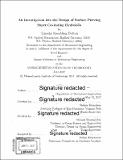An investigation into the design of surface piercing super cavitating hydrofoils
Author(s)
Dutton, Timothy Spaulding
DownloadFull printable version (8.405Mb)
Alternative title
Investigation into the design of SPSCHs
Other Contributors
Massachusetts Institute of Technology. Department of Mechanical Engineering.
Advisor
Stefano Brizzolara and Michael Triantafyllou.
Terms of use
Metadata
Show full item recordAbstract
The fluid-dynamic design of hydrofoils to support marine crafts at high speeds has received growing interest in recent years. Physics involved in the design of high-speed surface-piercing hydrofoils is complex involving three different fluid phases (air, water and vapor) and complex fluid dynamic mechanisms like unsteady cavitation and ventilation and their interaction. For speeds considerably higher than the incipient cavitation speed, the hydrofoil sections need to be adapted and design to exploit cavitation instead of avoiding it. This is particularly true for surface piercing hydrofoils that in addition to cavitation are affected by ventilation from the free surface. This thesis presents main results of an investigation into the relative formation of ventilation and cavitation regions of surface piercing super cavitating hydrofoils (SPSCHs), with special attention to the effects of cavitation number. A series of 3D multi-phase Reynold Averaged Navier-Stokes Equation (RANSE) simulations of varying cavitation number reveal the dependence of the ventilation and cavitation regions on the cavitation number, angle of attack, and distance from the free surface. The RANSE simulations are validated against an analytical estimate based on an appropriate lifting line method at near zero cavitation numbers, and against empirical results obtained through tow tank testing at higher cavitation numbers. The analytical and empirical validation bound the range of cavitation numbers considered in this study from [sigma]= 0.05 to [sigma]= 2.37.
Description
Thesis: Nav. E., Massachusetts Institute of Technology, Department of Mechanical Engineering, 2017. Thesis: S.M., Massachusetts Institute of Technology, Department of Mechanical Engineering, 2017. Cataloged from PDF version of thesis. Includes bibliographical references (pages 49-50).
Date issued
2017Department
Massachusetts Institute of Technology. Department of Mechanical EngineeringPublisher
Massachusetts Institute of Technology
Keywords
Mechanical Engineering.